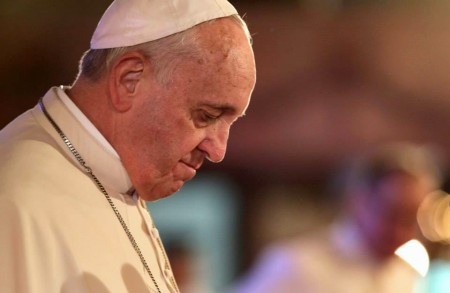We ask you, humbly: don't scroll away.
Hi readers, it seems you use Catholic Online a lot; that's great! It's a little awkward to ask, but we need your help. If you have already donated, we sincerely thank you. We're not salespeople, but we depend on donations averaging $14.76 and fewer than 1% of readers give. If you donate just $5.00, the price of your coffee, Catholic Online School could keep thriving. Thank you.Help Now >
Rome Notes: Women's Day; Rome's St. Frances
FREE Catholic Classes
An International Event, Little Known in U.S.
By Elizabeth Lev
ROME, MARCH 11, 2004 (Zenit) - On Monday morning, Romans awoke to a city abloom with sweet-smelling yellow mimosas for the "Festa della Donna," International Women's Day. While this international holiday has been sponsored by the United Nations since 1975, not many people in the United States are familiar with it.
Women's Day dates to the early 20th century as women in Europe and America began to campaign for the right to vote. This, coupled with the battle for better pay and decent working conditions, especially in the textile industry, incited the socialist women of America to initiate the first Women's Day in the United States, in February 1908.
After women garment workers organized the Shirtwaist Strike in 1909 and the death of 129 female textile workers in the notorious Triangle Fire of 1911 in New York, feminists and socialists throughout Europe took an interest in Women's Day. One hundred women from 17 countries attended the International Conference of Socialist Women in Copenhagen in 1911. There, Clara Zetkin proposed an International Women's Day, which was unanimously approved.
It took longer to set the date for this holiday. Originally set for March 19, it was eventually moved to March 8. According to most Italian accounts, the choice of date, proposed by Marxist agitator Rosa Luxembourg, was meant to correspond to the date of the Triangle Fire. The fire actually occurred, however, on March 25, the feast of the Annunciation, to this day known by British Christians as "Lady Day."
On March 8, 1917, (Feb. 23, under the Julian calendar then in use in Russia) working women of St. Petersburg protested for bread and peace giving rise to the so-called February Revolution. Alexandra Kollontai, one of the revolutionary leaders, convinced Lenin in 1918 to declare March 8 a national holiday in honor of the "heroic woman worker."
In her pamphlet written for International Women's Day 1920, Kollontai described the holiday as a "militant celebration" for "proletarian sisters." "Captive housewives" needed emancipation to attend meetings so they could be freed from the "shackles of the family, of housework, of prostitution."
The celebration of women finds a more comprehensive and less ideological expression in the writings of John Paul II, notably in the closing remarks of his 1988 apostolic letter "Mulieris Dignitatem."
The Church, writes the Pope, gives thanks for each and every woman, "for mothers, for sisters, for wives; for women consecrated to God in virginity; for women dedicated to the many human beings who await the gratuitous love of another person; for women who watch over the human persons in the family ...; for women who work professionally, and who at times are burdened by a great social responsibility."
The Marxist rhetoric and narrow definition of acceptable women's roles doesn't seem to disturb the Romans as they celebrate "la Festa della Donna" -- very few are acquainted with more than the Triangle Fire story. It is a day to give up a seat on the bus, smile pleasantly and offer a fragrant bouquet to mothers, friends, sisters and wives.
Italy can boast of having created Women's Day's most charming tradition, the yellow mimosa. Abundant at this time of year, the flower was chosen by the Union of Italian Women in 1946 for its vibrant, joyous color and its fragile appearance (which disguises a sturdy plant) as well as its traditional symbolism of life from death.
* * *
Workingwoman Extraordinaire
The day after Women's Day, Romans have further cause for celebration in the feast of St. Frances of Rome.
Born in 1384 to a noble Roman family, she married at the age of 12 and had three children, two of whom died very young. She persuaded many women of her social circle to give up a worldly, frivolous life to care for the poor and sick of Rome.
These women eventually became the Benedictine Oblate congregation of Tor dei Specchi. After her husband's death, Frances moved into the Oblates' convent and became prioress. Frances died on March 9, 1440, and was canonized by Paul V in 1608. She was buried near the Roman Forum, in the church of Santa Maria Nova, now known as Santa Francesca Romana.
Every year on March 9, the Oblates hold great festivities in honor of St. Frances. After the morning Mass, the sisters open the doors of their convent to the public for three days. One can visit not only the saint's room, but also the main hall of the building decked with delightful frescos, painted in the 1480s by the Renaissance artist Antoniazzo Romano.
The sisters chose a Roman artist to depict the life of their Roman saint. A series of lively, bustling scenes shows city life in the 15th century. The bright, cheery colors of the cycle convey the joyous dedication to God that distinguished the life of Frances.
Antoniazzo's frescos portray St. Frances as a "workingwoman," but a workingwoman who drew her strength from prayer and contemplation.
Ravaged by war, famine and floods, medieval Rome had very little in the way of social services. Frances filled this void, going against social customs which dictated that noble women should remain in the home. She found food for the hungry and healed the injured, especially victims of street violence.
In a number of the frescoes, Frances fearlessly ventures through the city; in the others she prays, either in community or alone with the visions that earned her a reputation as a mystic.
St. Frances admirably balanced her good works with her roles as a devoted wife and mother. One quotation attributed to her runs, "It is most laudable in a married woman to be devout, but she must never forget that she is a housewife. And sometimes she must leave God at the altar to find him in her housekeeping."
While today's Rome is remarkably free from violent crime, Frances' Rome was a dangerous city. St. Frances entrusted her safety to her guardian angel who appeared to her upon the death of her younger son. Only Frances could see her angel, although it is rare to see a painting of her without him by her side.
St. Frances is the patroness of widows, late vocations and ... drivers! The latter attribution makes her a precious intercessor on Rome's chaotic streets. When Frances traveled by night, her angel preceded her holding aloft a headlightlike lamp to help her find her way and shield her from harm.
This year, the events surrounding the feast of St. Frances will culminate next Sunday with a curious custom.
After presiding over Mass, Cardinal Angelo Sodano, Vatican secretary of state and titular cardinal of Santa Francesca Romana, will come out to Via dei Fori Imperiali to bless the assembled cars, cabs and drivers.
Anyone who has had occasion to drive in Rome knows that Frances has her work cut out for her!
* * *
The Invisible Monastery
The March 2 edition of Zenit carried a story of an impressive initiative, to create a network of Eucharistic adoration around Italy.
I went to see the remarkable woman behind this project, Sister Maria Rosa Lo Proto, director of the Center of the Union of Major Superiors of Italy, in her office at St. John Lateran.
Sister Maria Rosa is a Dominican nun of the Missionary Sisters of St. Sixtus. Born and raised in Palermo, Sicily, she has lived in Rome for the past 17 years. Tiny in stature, she exudes tremendous energy and infectious enthusiasm.
Three years ago the women religious of Italy started an a program in which religious sisters would choose a specific hour each week to dedicate to Eucharistic adoration. In 2003, they invited priests and lay people to participate. It has grown to 960 people with more joining every day.
Committed to her cause, Sister Maria Rosa brings her fliers personally from parish to parish explaining this "invisible monastery" and encouraging Romans to join.
When I entered her office, she played me a phone message from that morning. It was a woman calling after returning from her hour of adoration: "Thank you, Sister, for bringing me to this; I'm so happy."
I also asked her about the new "visible monastery," a weekly encounter of a representative group that gathers for Eucharistic adoration in the Church of Santa Maria della Pace.
"The encounter in the church is the 'icon' of the invisible monastery," she answered. "From October until the last Saturday in May, anyone can join the sisters, priests and lay people praying and singing before Jesus."
Santa Maria della Pace is one of Rome's most beautiful historic churches. A stone's throw from Piazza Navona, it contains frescos by Raphael, and its dramatic facade bears the design of the Baroque architect Pietro da Cortona. Why choose this church?
"The church was closed for many years for restoration," Sister Maria Rosa explained. "It so happened that the reopening coincided with the inauguration of the visible monastery. We thought it would be a beautiful thing if as the church was renewed and reintroduced to the city it could present a new function, a new life."
"Tourists who come and visit churches never see people praying in them. It is important that people see the church alive. It becomes a call, an invitation to prayer and adoration," Sister Maria Rosa added.
The stated aim of this initiative is prayer for vocations. I asked her how this speaks to lay people.
"Firstly, adoration is a much neglected aspect of prayer life. Yet the Holy Father exhorted us to take time for adoration in his 2003 encyclical 'Ecclesia de Eucharistia,'" she said. "Vocations are necessary for the Eucharist, and if there is no Eucharist, there is no Jesus."
Since the Pope has dedicated this year to the family, prayers are also said for families. "No families, no vocations," noted Sister Maria Rosa.
Traditionally, newlyweds would attend their first Mass after the wedding at Santa Maria della Pace to pray for peace in the family.
I went to Santa Maria della Pace last Saturday to see the response to this initiative. Some 40 people, mostly religious, filled the small space of the church. Various women religious directed the adoration with a local priest, Don Gino D'Anna, presiding.
Several tourists happened into the church, contenting themselves with silently contemplating the Raphael frescos near the entrance. The hapless tourist that ventured toward the center, camera in hand, found himself deftly steered away by Sister Maria Rosa flashing a brilliant smile and saying, "Jesus is present here right now."
A young Roman family attending the adoration set a heartening example as the mother explained what was happening to her 2-year-old daughter.
I caught up with them afterward and found out that they had traveled across the city to participate. It was the second time they had been to the church and they planned to return the following week. To them, the appeal was seeing "how art and prayer go so well together."
Contact
Catholic Online
https://www.catholic.org
CA, US
Catholic Online - Publisher, 661 869-1000
info@yourcatholicvoice.org
Keywords
Rome, Notes, Holy, See
 Hi readers, it seems you use Catholic Online a lot; that's great! It's a little awkward to ask, but we need your help. If you have already donated, we sincerely thank you. We're not salespeople, but we depend on donations averaging $14.76 and fewer than 1% of readers give. If you donate just $5.00, the price of your coffee, Catholic Online School could keep thriving. Thank you. Help Now >
Hi readers, it seems you use Catholic Online a lot; that's great! It's a little awkward to ask, but we need your help. If you have already donated, we sincerely thank you. We're not salespeople, but we depend on donations averaging $14.76 and fewer than 1% of readers give. If you donate just $5.00, the price of your coffee, Catholic Online School could keep thriving. Thank you. Help Now >
More Catholic PRWire
Showing 1 - 50 of 4,716
A Recession Antidote
Randy Hain
Monaco & The Vatican: Monaco's Grace Kelly Exhibit to Rome--A Review of Monegasque-Holy See Diplomatic History
Dna. Maria St. Catherine Sharpe, t.o.s.m., T.O.SS.T.
The Why of Jesus' Death: A Pauline Perspective
Jerom Paul
A Royal Betrayal: Catholic Monaco Liberalizes Abortion
Dna. Maria St.Catherine De Grace Sharpe, t.o.s.m., T.O.SS.T.
Embrace every moment as sacred time
Mary Regina Morrell
My Dad
JoMarie Grinkiewicz
Letting go is simple wisdom with divine potential
Mary Regina Morrell
Father Lombardi's Address on Catholic Media
Catholic Online
Pope's Words to Pontifical Latin American College
Catholic Online
Prelate: Genetics Needs a Conscience
Catholic Online
State Aid for Catholic Schools: Help or Hindrance?
Catholic Online
Scorsese Planning Movie on Japanese Martyrs
Catholic Online
2 Nuns Kidnapped in Kenya Set Free
Catholic Online
Holy See-Israel Negotiation Moves Forward
Catholic Online
Franchising to Evangelize
Catholic Online
Catholics Decry Anti-Christianity in Israel
Catholic Online
Pope and Gordon Brown Meet About Development Aid
Catholic Online
Pontiff Backs Latin America's Continental Mission
Catholic Online
Cardinal Warns Against Anti-Catholic Education
Catholic Online
Full Circle
Robert Gieb
We ask you, humbly: don't scroll away.
Hi readers, it seems you use Catholic Online a lot; that's great! It's a little awkward to ask, but we need your help. If you have already donated, we sincerely thank you. We're not salespeople, but we depend on donations averaging $14.76 and fewer than 1% of readers give. If you donate just $5.00, the price of your coffee, Catholic Online School could keep thriving. Thank you.Help Now >
Three words to a deeper faith
Paul Sposite
Relections for Lent 2009
chris anthony
Wisdom lies beyond the surface of life
Mary Regina Morrell
World Food Program Director on Lent
Catholic Online
Moral Clarity
DAN SHEA
Pope's Lenten Message for 2009
Catholic Online
A Prayer for Monaco: Remembering the Faith Legacy of Prince Rainier III & Princess Grace and Contemplating the Moral Challenges of Prince Albert II
Dna. Maria St. Catherine Sharpe
Keeping a Lid on Permissiveness
Sally Connolly
Glimpse of Me
Sarah Reinhard
The 3 stages of life
Michele Szekely
Sex and the Married Woman
Cheryl Dickow
A Catholic Woman Returns to the Church
Cheryl Dickow
Modernity & Morality
Dan Shea
Just a Minute
Sarah Reinhard
Catholic identity ... triumphant reemergence!
Hugh McNichol
Edging God Out
Paul Sposite
Burying a St. Joseph Statue
Cheryl Dickow
George Bush Speaks on Papal Visit
Catholic Online
Sometimes moving forward means moving the canoe
Mary Regina Morrell
Action Changes Things: Teaching our Kids about Community Service
Lisa Hendey
Easter... A Way of Life
Paul Spoisite
Papal initiative...peace and harmony!
Hugh McNichol
Proclaim the mysteries of the Resurrection!
Hugh McNichol
Jerusalem Patriarch's Easter Message
Catholic Online
Good Friday Sermon of Father Cantalamessa
Catholic Online
Papal Address at the End of the Way of the Cross
Catholic Online
Cardinal Zen's Meditations for Via Crucis
Catholic Online
Interview With Vatican Aide on Jewish-Catholic Relations
Catholic Online
Pope Benedict XVI On the Easter Triduum
Catholic Online
Holy Saturday...anticipation!
Hugh McNichol












 Daily Readings for Saturday, April 20, 2024
Daily Readings for Saturday, April 20, 2024 St. Marian: Saint of the Day for Saturday, April 20, 2024
St. Marian: Saint of the Day for Saturday, April 20, 2024 Children's Prayer For Parents: Prayer of the Day for Saturday, April 20, 2024
Children's Prayer For Parents: Prayer of the Day for Saturday, April 20, 2024

